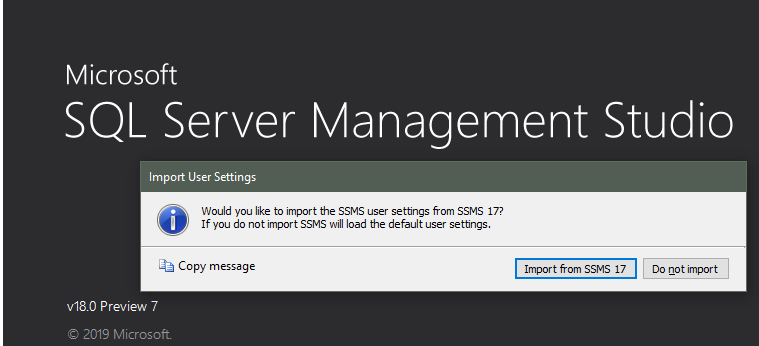SQL Server Management Studio 18.0 Public Preview 7 Released
After a brief gap since releasing SQL Server Public Preview 6, and having survived through the February 2019 Snowcalypse in Seattle, I’m happy to share that everyone in the SQL Tools team has made it out alive. I am also very excited to announce the Public Preview 7 of SQL Server Management Studio (SSMS) 18.0 is now available. We’ve added new features, and a host of bug fixes in this incremental build.
You can download SSMS 18.0 Public Preview 7 today and find additional details in the Release Notes.
SSMS improvements include:
- When connecting to Azure SQL Database Managed Instance (DB/MI), you can connect to it with “<Default>” as the initial db.
- SSMS settings migration (from 17.x and older to 18.0 Preview) – When you install SSMS 18 Public Preview 7, it detects any existing versions of 17.x or older and prompts the user if they want to migrate the SSMS settings to SSMS 18. This is a one-time prompt and only happens if a previous version is detected.

- Added Showplan support to LocalCube RelOp for DW ROLLUP and CUBE
- Added support for Edge Constraint in the Graph database
- Added support to import/export data tier application with graph tables
- Added Cloud Witness as a new quorum type and as a new resource type in both SQL Server Management Objects (SMO) and SSMS
- Added AAD logins as a new login type in SMO and SSMS when connected to an Azure SQL Database Managed Instance
SSIS Improvements include:
- Added a new entry item Try SSIS in Azure Data Factory under the Integration Services Catalogs node, which can be used to launch the Integration Runtime Creation Wizard and create Azure-SSIS Integration Runtime quickly.
- Added a Create SSIS IR button in the Catalog Creation Wizard that can be used to launch the Integration Runtime Creation Wizard and create Azure-SSIS Integration Runtime quickly.
- ISDeploymentWizard now supports SQL authentication, Azure Active Directory integrated authentication, and Azure Active Directory password authentication in command-line mode.
Azure Data Studio Integration:
- Users can now right click on a database node in Object Explorer, and either run a query or create a new notebook in Azure Data Studio
Data Classification
- Added new Data classification feature to SMO. The column object exposes the following new properties: SensitivityLabelName, SensitivityLabelId, SensitivityInformationTypeName, SensitivityInformationTypeId, and IsClassified (read-only). For more information, see Add Sensitivity Classification.
- Added new Classification Report menu item to the DC flyout
- Fixed an issue where “[n/a]” was missing in both the SensitivityInformationType and SensitivityLabelName
Vulnerability Assessment
- There’s been work done to ensure the VA scan result on Managed Instance will be consistent with those that are run in Azure
- Vulnerability Assessment now supports Azure SQL Data Warehouse
In addition, we also have several bug fixes in the following areas:
SSMS:
- Fixed an issue with the Import Flat File Wizard being unable to process negative decimal values
- Fixed an issue with the Import Flat File Wizard failing when there were duplicate columns in the file being imported. We let the wizard progress by identifying and renaming the duplicate columns.
- Fixed an issue where the New XEvent Session Wizard UI form was not rendered properly on High DPI monitors
- Fixed an issue where trying to display the properties of a database (with FILEGROWTH > 2048GB) was throwing an arithmetic overflow error
- Added support for UTF8_BIN2 collation
- Fixed an issue where SSMS didn’t open the file when you double clicked a .sql file
- JSON support in Data Masking
- Memory Optimized and Temporal tables are now able to be masked. Some restrictions still apply to the Memory Optimized and Temporal tables themselves.
- Masked database is now set to SIMPLE recovery mode while the masking operation is in progress to reduce log use, then returned to its original value after completion.
Object-Scripting:
- Fixed an issue which was causing the database scripting (of a SQL Azure database) to always target an on-prem SQL, even if the Object Explorer scripting settings were set to match the source.
- Fixed an issue when trying to script a table in a SQL DW database involving clustered and non-clustered indexes was generating incorrect T-SQL statements.
- Fixed an issue when trying to script a table in a SQL DW database with both Clustered Columnstore Indexes and Clustered Indexes were generating incorrect T-SQLs (duplicate statements).
- Fixed partitioned table scripting with no range values (SQL DW databases).
- Fixed an issue where the user would be unable to script an audit/audit specification SERVER_PERMISSION_CHANGE_GROUP.
- Fixed an issue where the user was unable to script statistics from SQL DW. Review feedback to learn more.
Managed Instance:
- Fixed an issue which was causing right-clicking on a database and choosing import data-tier application to fail
- Fixed an issue that was causing errors upon right-clicking on a TempDB
- Fixing an issue when trying to script ALTER DB ADD FILE statement in SMO was causing the generated T-SQL script to be empty
For a full list of changes, please see the Release Notes.
As always, if you have a previous version of SSMS 18.0 preview, you will need to uninstall it first. SSMS 18.0 Public Preview 7 can be installed side-by-side with SSMS 17.x for testing purposes. As a reminder, the use of pre-GA software in production environments is not supported.
We’d love to hear from you with any questions, comments or feature suggestions.


